If you're a diver, you've probably already seen a lot of SeaLife cameras. Pretty much no matter where you go, someone has a SeaLife, and they are at almost every dive show, too. That's because SeaLife's been doing underwater cameras since 1993, and underwater digital cameras since 2000. The company prides itself in offering a whole array of underwater cameras and accessories, with all the strobes and lenses interchangeable with any SeaLife camera. SeaLife's business model is simple: start with a basic digital camera, tweak it for underwater use, make a bullet-proof underwater housing for it, and then offer the camera in various configurations with or without external flashes, light, lenses and other accessories.
The DC1400 is SeaLife's latest and greatest, and ScubaDiverInfo.com had a chance to put their Pro Duo package, complete with strobe and video light, through its paces during a recent camera review trip to one of our favorite dive locations, the Honduran island of Roatan. Here's what the DC1400 looks like in its housing:
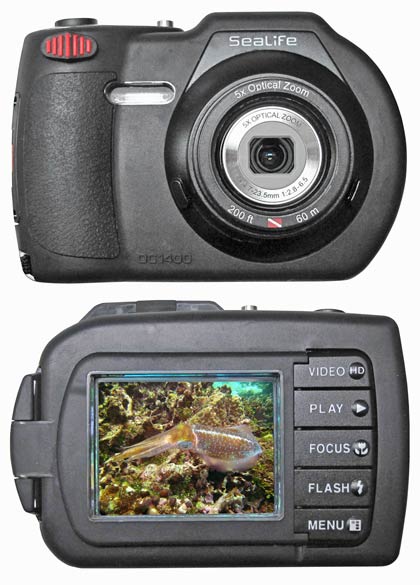
What is the DC1400, and what is new?
The DC1400 is SeaLife's most recent underwater digital camera. You now get 14 megapixel pictures. There are various improvements here and there that increase overall performance and versatility. For most customers, the biggest step forward is the addition of 720p video. That's a high definition format that goes well with today's flatscreens, and it's a full three times the number of pixels of standard the VGA video (1280 x 720 instead of 640 x 480) older SeaLife cameras were limited to.
Sealife usually sells their cameras in various bundles that either contain just the camera and housing, or the camera, housing, strobe(s), lenses and other useful things. We got the DC1400 Pro Duo package (US$1,129 list) that includes the camera with housing, one SL961 Digital Pro Flash with optical flash link, one SL980 Photo/Video Light, brackets and arms for both, a travel case, and some odds and ends. Below you can see the contents of the DC1400 Pro Duo package:

A tough housing that works
Those familiar with Sealife cameras know that unlike those clear plastic consumer camera underwater cases with their bright color accents, SeaLife underwater housings are all business. They are made of tough polycarbonate completely encased in grippy black rubber overmolding. All that rubber makes perfect sense underwater where the camera may bump against rocks, get dragged along the bottom, and is just generally exposed to more abuse than above water. And it also provides extra shock protection should you drop the camera while on land (or on a boat). The SeaLife DC1400 housing can handle depths to 200 feet—a lot deeper than the 130 feet depth limit recommended for recreational diving.
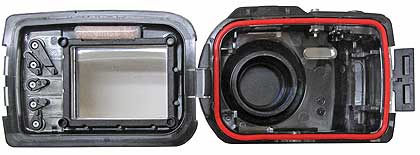
Case construction is simple. It's a hinged clamshell with a fairly small latch that can be a bit of a fingernail buster. The case is easy to hold and ergonomically correct. In a big improvement over past SeaLife cases, the all-important O-ring is now bright red so you can see it, and sits firmly in its groove. That makes it much easier to see if the crucial seal is properly in place, and you can also easily see if the O-ring is in good condition or not.
The flash assembly that comes with the Pro (one flash) and Duo (one flash and one video light) packages is equally handy and no-nonsense. Unlike some strobe and bracket gear that are unwieldy and weigh a lot, the plastic/rubber/foam rubber SeaLife flash assembly is light and doesn't get in the way. The arm is not very long—just about eight inches—but, lacking the usual adjustment knobs and wheels, is simple to bend into whatever position, angle and direction you want.
As was the case with its DC1200 predecessor, this latest SeaLife housing has done away with tiny buttons that are hard to see and operate under water. Instead, there are five large push controls that SeaLife calls "piano keys." If that sounds like a minor thing, it's not. It makes the camera infinitely easier to use underwater. The camera itself, interestingly, has reverted back from keys to a simplified set of buttons.
Below you can see the SeaLife DC1400 in action:
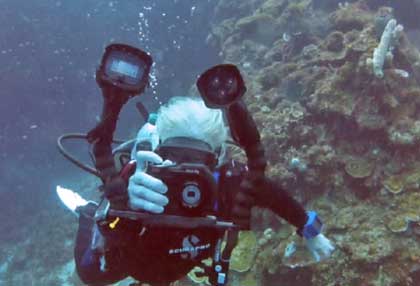
DC1400 specifications and features
Unlike SeaLife's heavily sealed and armored Mini II that combines camera and protective housing, the DC1400 camera by itself looks no different from most other modern digital point & shoot cameras. Its 14 megapixel imager is up by two megapixel from the predecessor DC1200 and you now 4,288 x 3,216 pixel to work with in maximum resolution. That is plenty enough for making large prints as well as cropping pictures to your heart's content and zooming in to the smallest detail. You can also set the camera to various lower resolutions modes (you don't need 14mp if all you want is email a picture or publish it on the web) and set the image compression level (fine/standard/economy) to manage file size.
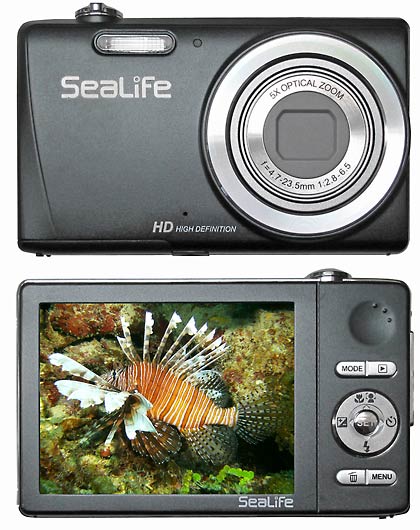
The camera comes with 32MB of onboard memory (why do cameras still have so very little storage in the era of smartphones and iPods with as much as 32GB, a thousand times more?) and an SDHC Card slot that can handle memory cards with up to 32GB capacity.
Focal length is 4.7 to 26.5 millimeters, equivalent to 26 to 130mm in the old 35mm film camera parlance. The camera has a 5X optical zoom (plus 6X digital magnification, which we never recommend using). 26mm means a return to a significantly wider angle starting point than recent SeaLife models. A good move as you hardly ever need a long zoom underwater whereas you can't ever have an angle wide enough.
Movies can now recorded in 1,280 x 720 pixel model, or "720p." That means the wide 16:9 aspect ratio and standard HD format required to let your video shine when played back on today's HD flatscreen TVs. The move from the old and narrow looking 640 x 480 format of the DC1200 to the contemporary 720p may well be the biggest advance in the DC1400, and for many the primary reason to buy, or switch to, this camera.
Sensitivity, while generally best left in automatic, can be set to 100, 200, 400, 800, 1600 or even 3200 ISO, up a step from the older model. There is a self-timer, and the built-in flash now has a full eight modes: automatic, on, off, slow-sync, macro, far flash, and red-eye reduction.
According to the manual, the normal focus range goes from two feet to infinity, and there's a new super-macro mode that lets you get as close as an inch (not recommended with excitable sea critters).

While cameras trended to larger and larger LCD screens for several years, that seems to have stopped and the DC1400's screen stays 3.0 inches. Resolution remains unchanged as well at 230k pixel, making the LCD one of the weaker points of the camera. You can toggle brightness between normal or full bright.
The DC1400 is a point & shoot camera that you set either in automatic mode or one of well over 30 scene modes. The scene modes we're familiar with from the DC1200 are:
- Automatic
- Dive (diving 25+ft without lights)
- Snorkel (diving up to 25 feet without lights)
- Ext Flash Auto
- Ext Flash Manual
- Intelligent scene (camera decides scene mode)
- Panorama PanCapture (camera combines pictures into panorama)
- Landscape (sets infinity, high saturation, hard sharpness)
- Sunset (optimizes deep hues typical for sunsets)
- Sunrise (optimizes deep hues typical for sunrises)
- Snow (to optimize colors in snow scenes)
- Beach (to optimize detail in bright scenes)
- Sports (captures fast-moving subjects)
- Night Scene (best for capturing dark scenes)
- Splash Water
- Flow Water
- TV (shutter priority)
- AV (Aperture priority)
And these are new for the DC1400:
- Skin soften (smoother portraits)
- De-blemish (eliminates blemishes)
- Portrait male (makes male makes portrait stand out better)
- Portrait female (makes female makes portrait stand out better)
- Night Portrait (captures people in night scenes)
- Candlelight
- Smile detection (takes picture when it sees a smile)
- Anti-shake (engages anti-shake)
- Fireworks (best exposure for fireworks, needs tripod)
- Text (best for black on white)
- Pets
- Natural Green (brightens colors in green scenes)
- Program AE (manual except shutter and aperture)
- Ext Light (auto with just video light)
- Ext Light + Flash (auto with video light and flash)
Anti-shake is available both as a setting and as a separate scene mode; in the predecessor DC1200 it was either on or off. The fully manual settings mode is available only in the manual external flash mode where you can choose from AV f/2.8 or f/7.9 and set TV from 1/2,000th to one second in many steps. Make sure you try them out as proper depth of field can make a huge difference in underwater photography.
In "Snorkel" and "Dive" modes, you get special white balance settings for shooting in depths of up to 25 feet (default for snorkel) and one for shooting below 25 feet (default for dive). That's because red only penetrates about ten feet and orange disappears at 25 feet, so a white balance that takes that into consideration really matters. SeaLife has been working with ways to handle this phenomenon over the years. In the DC1400, you set white balance by depth and select from:
- Blue Water<25ft (for snorkeling and shallow diving)
- Blue Water>25ft (for deeper diving in "blue" water)
- Green Water<25ft (for snorkeling and shallow diving in water with higher algae content)
- Green Water>25ft (for deeper diving in "green" water with higher algae content)
You can also set the white balance manually, and we've had very good results with that as well (a white fin came in very handy in calibrating the white balance).
The other underwater modes, "External Flash Auto," "External Flash Manual", and the new External Light and External Light and Flash are used with one or both of SeaLife's external flash and video light accessories, and those are a must-have for serious underwater photographers. Note that SeaLife uses an optical external flash trigger: the light from the internal flash is picked up by an optical cable and triggers the external flash.
The DC1400 also has a number of different capture modes:
- Single
- Continuous (up to three images)
- AEB (three shots with exposure bracketing)
- SPY (interval shooting from 10 seconds" to one shot every hour)
- Cont. Flash (like continuous, but with flash)
- Burst (continuous shooting)
- Burst (continuous shooting 30fps at 640 x 480)
- Pre-Shot (two-step process that lets you select a background, then have someone else take the shot)
- Couple Shot (let's you combine two people into one shot)
- Album Shot (puts three shots into an album-like layout)
"Pre-Shot" is for when you want to predetermine a background that you can then quickly go back to, or have someone else take the picture. It works by taking a faint ghost picture that stays on the screen so you can easily match the background again. The ghost background picture is just for help; it does not actually record. A variation of pre-shot is "Coupl.Shot" where you take a picture of a subject on the left side, then use the ghost to line up and add a second person (like the photographer) into the picture. The two are combined.
Over the years, SeaLife has experimented with making their cameras as easy to configure and use as possible, and their latest Easy Set-up mode indeed couldn't be simpler: Are you shooting underwater or on land? If underwater, are you using a flash, a video light, both, or just the camera? If flash and/or video light, that's it. If camera, are you snorkeling or diving deeper than 25 feet? If you select "land," that's it, no further questions. What is a bit amazing, given the utter simplicity of the tens of millions of increasingly better smartphone cameras, is the inclusion of so very many settings when underwater you want as few as possible.
SeaLife external flash system
When it comes to taking pictures underwater, light is absolutely everything. There is a stunning world of color down there that non-divers often simply cannot believe is true, but you cannot always see it because light and colors are different underwater. Colors are just different wavelengths reflected by objects, and underwater, these waves travel differently and some are filtered out by water sooner than others as you go deeper. Red disappears first, then orange, and then yellow. Green stays longer and blue the longest, which is why things look bluer the deeper you go. So if you want to capture all those colors, you need a strong flash for pictures and a strong light for video.
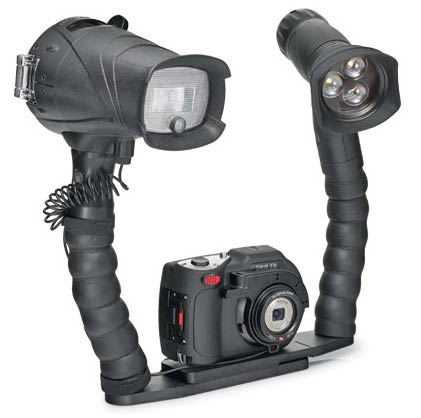
Our DC1400 Pro Duo package came with both a single flash and a photo/video light (see above). The optical flash link snaps onto the underwater housing. It covers the internal flash window so it can pick up the firing of the camera's flash without letting the internal flash illuminate debris that results in "scatter" on images.
SeaLife's Digital Pro Flash is an extensively field-tested and very mature product that uses four regular AA batteries, has a pre-flash and an automatic mode switch that can be set to accommodate SeaLife or non-SeaLife cameras. The flash also has an external flash intensity control knob that can be set to automatic or manual control of flash intensity, from darkest to brightest. In our testing, this (and every other we ever tested) SL961 Digital Pro Flash was near perfect; we never once had to adjust it or try different settings, and the NiMH rechargeables we used lasted a long time.
Obviously, an external flash adds a bit of size and bulk to the camera setup, but that's not much of an issue once you are underwater. The flash arm is tightly wrapped in grippy foam and can easily be adjusted. If anything, some divers may consider the roughly 8-inch extension not long enough to get the proper lighting angle.
Do allow ample time to get used to the flash. Proper positioning can make all the difference for a shot. Try different angles and distances as that can be the difference between a great shot and one where the flash simply illuminates debris in the water. Once you get the hang of it, you'll be rewarded with wonderfully rich, colorful pictures that are simply not possible without a flash
The video light plays an equally (and sometimes even more) important role. The DC1400's 720p video mode makes gorgeous high definition footage possible but it, too, needs light for sharpness and, especially, colors. The SeaLife photo/video light has three LED that together generate about 500 lumen (and for brief periods 600 lumen in "power overdrive" mode). The light is a clever design that you can quickly disconnect from its arm so that you can illuminate whatever needs illuminating without affecting a recording. The light also uses four AAs and there's just a single external button for operation. You use it to turn the light on and off, and to toggle through three power levels (100%, 50%, and 25%). Inside the body is a set of toggle switches where you can program flash cancellation modes where the light goes off or reduces intensity when it detects a flash.
Underwater experience with the DC1400
We tested the DC1400 Pro Duo system during a eight-day product review trip that took us back to the Honduran island of Roatan. There, I used the DC1400 on most of my 24 dives that ranged from fairly deep (120+ feet) wall dives, to wreck dives, to just playing in the shallow reefs. The following are notes and opinions we recorded throughout the trip.
Love the "piano keys" — We're thrilled that the DC1400 housing has five large keys with large white labels for the major functions (Video/Still, Playback, Focus, Flash, and Menu) instead of making divers mess with tiny buttons underwater. It makes use of the camera while diving much simpler. Interestingly, while the DC1200 had keys on the camera itself, the DC1400 camera reverted to a more traditional arrangement. Thanks, SeaLife, for keeping the keys on the housing!
Consistently good pictures — The second pleasant surprise is picture quality. The DC1400 does something that is all too rare underwater: virtually all pictures came out well. You can't take that for granted. The camera did very well with colors, focus, and exposure. In fact, the captured pictures always looked much better than what I saw on the screen (which is another argument for a sharper, larger LCD).
Battery — As was the case with the DC1200, the DC1400's battery is undersized. It never lasted me more than a dive and a half, and sometimes died before the end of the first dive. In a dive camera, you really need a battery that lasts. So always bring a spare or two. The camera should also come with a battery charger. As is, you have to charge the battery in the camera via a cable. Divers often want to charge one battery while in the water with the other. You can't do that if you need to plug in the camera.
Flash — The flash, as in past tests, worked exceptionally well. It is very light, very easy to use and handle, and also easy to adjust underwater. We missed the clever flash diffuser accessory that eliminates backscatter; it's part of the Pro Duo package, but was missing in ours. Do note that in External Flash mode (which is what we used 90% of the time), the flash always fires. That's generally a good thing as the diffuser (if you have it) helps illuminating subjects without also illuminating scatter. However, there are times when there is a lot of floating stuff in the water and not much light, and scatter will show up. In those cases, either cover the flash with your hand, point it away, or simply turn it off.
Shutter and zoom buttons — The DC1400 has a nice, large shutter button. And to move up and down in menus, you use the zoom lever. That's much better than a tiny button diamond. The spring on the zoom lever, though, was a bit weak and the zoom tended to stick.
HD video! — I cannot overemphasize how much better the DC1400's 720p HD video is than the old VGA (640 x 480) mode of the DC1200. You get over three times the pixels and the wide 16:9 format is what is needed for today's TVs and monitors. We could ask for full 1080p video, but for now, 720p looks virtually as good as 1080p on most flatscreen HDTVs.
White balance — There is no easy setup for video, and so you have to set white balance manually. And since SeaLife offers many underwater white balance settings, some experimentation is required to get it right. Depth really matters, and if you use a deepwater white balance ion shallow dives, everything is too red. Note that the degree of sunlight makes a big difference, too. On a bright sunny day there will be more red, and you can use the shallower than 25 feet white balance much farther down.
LCD viewing angle — The LCD is bright, especially with the extra brightness setting on, but underwater it remains hard to see. The problem is contrast more so than brightness, and the small vertical viewing angle of the LCD makes it worse. You have to look at the display head-on to see much, and that isn't always possible when diving. The LCD does not do this otherwise good camera justice. I often took a picture thinking it would not come out because the display showed next to nothing, and then the picture came out well and had much more contrast.
Fogging — After having some vexing fogging issues with last year's DC1200 package, I was pleasantly surprised to find that the DC1400 had no fogging problems whatsoever. We did use desiccant cartridges on every dive and that certainly helped.
Housing — The housing is much improved! We love the red O-ring instead of the older black ones you could not see, and we love that the O-ring stays put instead of easily popping out. This way, there's MUCH less of a chance to flood the housing because the ring is bad or fell out. The safety latch, though, is still a fingernail buster.
Base — We'd like the bracket base a bit wider. As is, with the video light installed, there is hardly room to hold the camera setup properly.
Video light — We loved the addition of the video light. It's light, handy and bright. Unfortunately, we ran into a problem with ours where underwater it would no longer turn on. Above water it would come on by itself. Sometimes it would come on, then turn off, and sometimes it worked fine the first time, but did not come on a second time. We asked others who used the same light, and they did not have this problem.
Overall, I loved using the DC1400. It combines a lot of features and functionality into a handy and easy-to-use package. Everything seems optimized for the job and it's clearly obvious that SeaLife has a lot of experience in getting things just right.
Keeping things in focus
When you shoot pictures underwater, using the right focus mode can be the difference between stunningly sharp shots and blurry frustration. It definitely pays to read up on a camera's focus modes and get a feel for what they can do before going live underwater. Older SeaLife cameras could be a bit confusing because their focus modes overlapped and it wasn't easy to figure out which one to pick.
If you're used to earlier SeaLife cameras, things have changed with the DC1400. There are now no fewer than six focus settings:
- Super-Macro — good from as close as an inch to infinity (without zoom)
- Macro — good from as close as four inches to infinity (without zoom)
- Auto Focus — good from two feet to infinity (without zoom)
- Infinity — works from about three feet to infinity and is fast because the focus is locked and so the auto focus won't spend time hunting.
- Auto Focus Tracking — tracks moving objects
- Face Detect — camera focuses on faces
You won't use AF Tracking (too much moving stuff underwater) and Face Detect underwater, but the first four focus settings bear studying. The good news is that all of those focus modes now go to infinity, so you no longer have the narrowly overlapping focus modes of the older SeaLifes.
To test the real-life focus ranges under ideal conditions, we did 24 test pictures with the DC1400—six each in the four main focus modes—in a controlled environment, taking the same shot from within an inch, four inches, a foot, two feet, three feet, and four feet, which is about the range when you're rummaging around a reef or some other interesting macrolife.
The table below shows what modes, according to our test pictures, work best at what distance with the DC1400:
|
Focus/Distance
|
1 inch
|
4 inches
|
1 foot
|
2 feet
|
3 feet
|
4 feet
|
|
SUPER-MACRO
|
Sharp
|
Sharp
|
Marginal
|
Marginal
|
Marginal
|
Marginal
|
|
MACRO
|
Blurry
|
Sharp
|
Sharp
|
Sharp
|
Sharp
|
Sharp
|
|
AUTO-FOCUS
|
Blurry
|
Blurry
|
Sharp
|
Sharp
|
Sharp
|
Sharp
|
|
INFINITY
|
Blurry
|
Blurry
|
Sharp
|
Sharp
|
Sharp
|
Sharp
|
As you can see in the table, you can go incredibly close in Super-Macro mode with the DC1400 (if a subject lets you). And you can even use the Super-Macro mode for subjects farther away. Most of the time they are actually sharp all the way to infinity. The only reason why we marked them "marginal" is because Super-Macro mode is very slow as the lens seeks optimal focus, so it's definitely not recommended as the standard setting.
Picking between the remaining three modes depends on your shooting. If you're in calm waters with good light and do mostly close-ups, just leave the camera in macro. If you don't generally go in close and have enough light, use standard auto-focus. In rougher conditions with less light, you're best off leaving the camera in the Infinity setting.

The SeaLife DC1400 Pro Duo
What you get with SeaLife's DC1400 Pro Duo package is a small and fairly simple 14-megapixel camera that's been optimized for underwater shooting, a superb underwater case, a tried-and-true underwater flash, a 500 lumen video/photo light, plus some assorted cables/chargers/manuals in a nice soft carry case.
SeaLife's "piano-key" controls make it easy to quickly change settings. They can be operated even with gloves on, and having quick and simple access to large controls will result in better pictures. We also liked the large shutter and zoom.
The DC1400 camera itself did very well. It was forgiving, quick, and we managed to get a lot more good pictures than with almost any other underwater camera in this price range.
The 3-inch LCD is large, but its moderate resolution and small vertical viewing angle makes it difficult to see and use underwater.
The DC1400 adds 720p HD video. The difference in quality and impact over smaller recording formats is tremendous.
The flash was a pleasure to use. It seemed extremely well matched with the camera and we didn't have to experiment with settings at all. The detachable photo/video likewise is very easy to use and adds a lot of functionality to the package.
Overall, the DC1400 represents an excellent value. It's not meant to replace a dSLR, but it also costs much less. And compared to standard point & shoot cameras with underwater housing, the SeaLife package is much better optimized for underwater use.
We like:
- Handy 14-megapixel camera with excellent underwater case (200 feet depth)
- Without housing, it's a small and handy digital camera for use anywhere
- Tough, rugged housing simple to use and operate
- Housing now has easy-to-see and firmly seated red O-ring
- 720p 1280 x 720 pixel HD video
- Excellent "Easy Set-up" wizard
- 5X zoom starts at a wide 26mm
- "Piano key" control arrangement on housing works great!
- Large shutter and zoom
- Very good picture quality with most pictures coming out well
- Handy external flash with easy-to-manipulate arm
- Excellent detachable video/photo light
- Experienced no fogging problems
Keep in mind:
- Undersized battery only lasted a dive and a half
- LCD has low contrast and narrow vertical viewing angle
- Getting the proper white balance for a depth and lighting condition takes practice
- Housing latch a fingernail buster
- Weak zoom lever spring had zoom sticking a few times
- Would like separate battery charger instead of charging in-camera
- With iPods and iPhones having up to 32GB memory, why only 32MB onboard?
- Macro and Super-Macro modes great, but slow to focus










